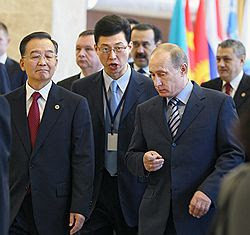
The Chinese -Russian Gas Powered Merry-go-round
by Roman Kupchinsky
The signing of a general trade agreement on October 14 between two state owned energy companies – Russia’s Gazprom and China’s National Petroleum Corporation (CNPC)- to supply China with 68 billion cubic meters of gas yearly, not only caught many energy analysts off-guard but also made them highly skeptical.
The agreement was signed during Vladimir Putin’s first visit to China in his new role as Prime Minister.
Russian Deputy Prime Minister Igor Sechin, who is also the chairman of the board of Rosneft, Russia’s largest producer of crude oil, said Gazprom and CNPC might set a price (for the gas) in the course of further talks and sign a contract in early 2010. In that event, supplies would likely start in 2014 or 2015.
Shipments could reach China by new pipelines or as liquefied natural gas aboard tankers, he said.
The Moscow Times, however, reported that Alexei Miller, the CEO of Gazprom, told a Russian-Chinese business forum that the price for Russian gas to China would be based on the price of oil products, the same formula used by Gazprom in its European export contracts.
Russian-Chinese gas purchase talks began in 2004 and thus far have not yielded any results. Pricing has been an ongoing issue between the two sides, but the main concern analysts have is Russia’s ability to supply 68 bcm of gas per year to China while meeting long-term commitments to European customers as well as rapidly increasing Russian domestic demand for gas.
Earlier this year, Gazprom announced that gas from the Sakhalin-1 project will not be sold to China, but diverted instead to the gas hungry Russian Far East region of Vladivostok. Gazprom is holding talks with Exxon about buying all of its gas output from Sakhalin and industry sources say the company is offering prices equal to Russia’s domestic gas prices – which are far below world prices. Exxon said it is studying all options to sell gas from Sakhalin-1.
In addition to making promises to supply China, Gazprom has also stated that it wants to capture 10 percent of the U.S. gas market within the next 5 years by selling some 66 bcm of gas in the form of LNG. The plan envisions that Sakhalin-2 will supply the bulk of this LNG.
The bottom line is whether Russia is capable of building such costly pipelines as Nord Stream, South Stream and a second string of Blue Stream; while at the same developing the Yamal peninsula into a major gas producing center and finishing the Shtokman project? These projects, and others too numerous to mention, are projected to cost hundreds of billions of dollars which Russia does not have and which Western companies might not want to spend given the shaky business reputation of Gazprom and its management.




